Business Law Report: Analysis of Consumer Rights and Agreements
VerifiedAdded on 2020/12/09
|14
|5537
|79
Report
AI Summary
This report delves into various aspects of business law, focusing on consumer rights and agreements. It examines legal rules of implied terms in the sale of goods and services, statutory provisions on property transfer, and remedies for buyers and sellers. The report also explores product liability for faulty goods. Furthermore, it analyzes different types of credit agreements, termination of rights, and default notices. The report also covers agency law, including its features and types of agents. Additionally, it investigates monopolies, anti-competitive practices, and the role of the Competition Commission. Lastly, the report discusses intellectual property rights, including patents, copyrights, and trademarks, and the legal rules preventing infringement. The report uses the case of Ben, a consumer, to illustrate the application of these legal principles in real-world business scenarios.
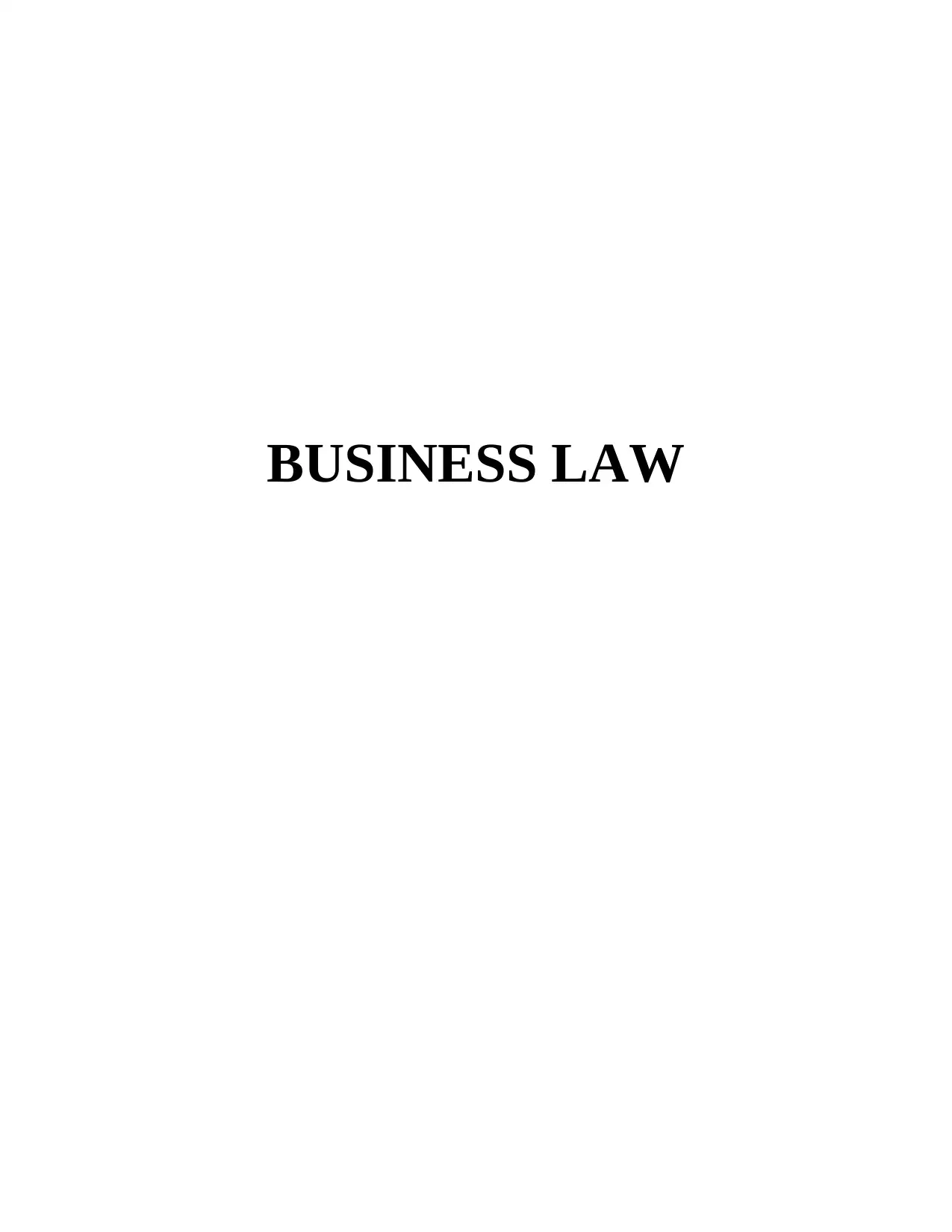
BUSINESS LAW
Paraphrase This Document
Need a fresh take? Get an instant paraphrase of this document with our AI Paraphraser
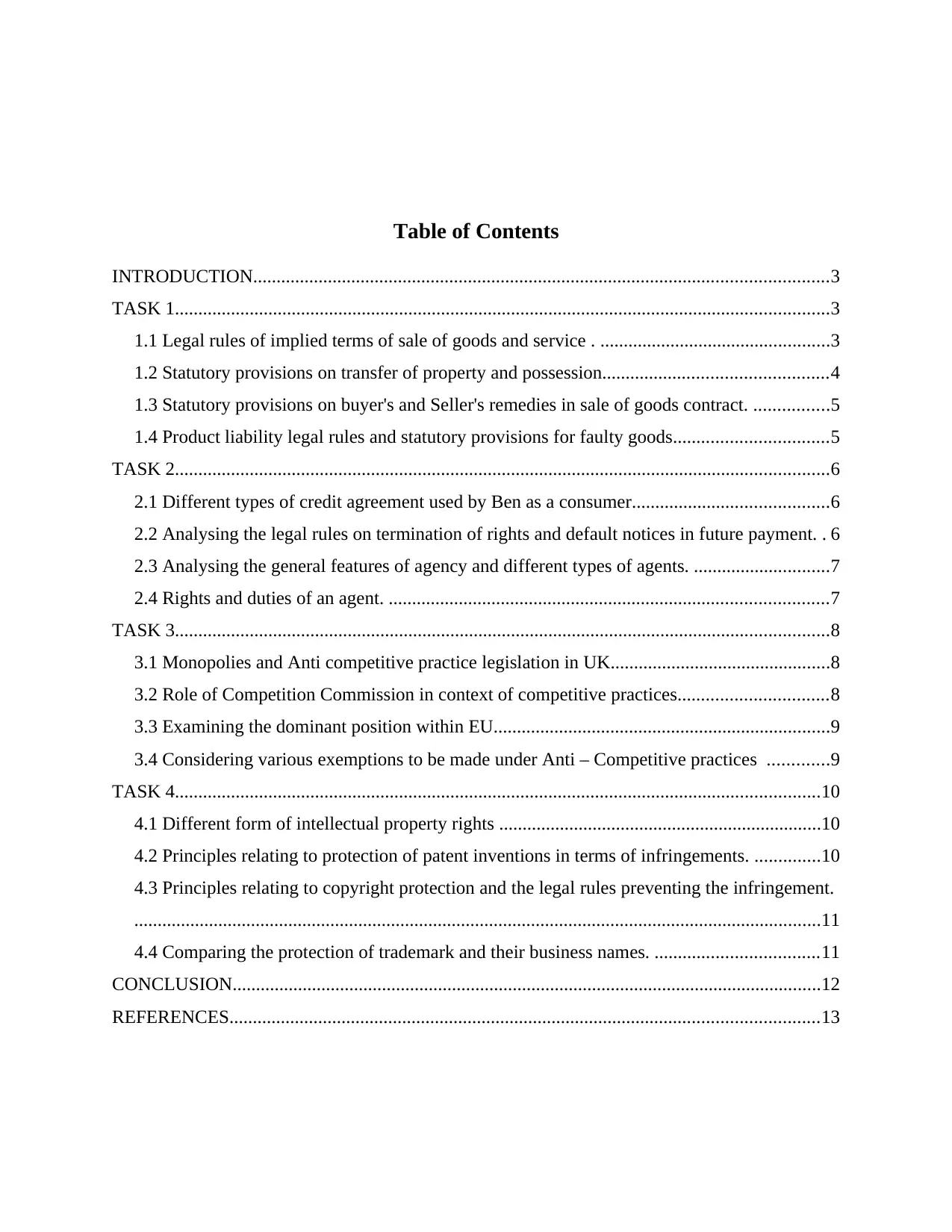
Table of Contents
INTRODUCTION...........................................................................................................................3
TASK 1............................................................................................................................................3
1.1 Legal rules of implied terms of sale of goods and service . .................................................3
1.2 Statutory provisions on transfer of property and possession................................................4
1.3 Statutory provisions on buyer's and Seller's remedies in sale of goods contract. ................5
1.4 Product liability legal rules and statutory provisions for faulty goods.................................5
TASK 2............................................................................................................................................6
2.1 Different types of credit agreement used by Ben as a consumer..........................................6
2.2 Analysing the legal rules on termination of rights and default notices in future payment. . 6
2.3 Analysing the general features of agency and different types of agents. .............................7
2.4 Rights and duties of an agent. ..............................................................................................7
TASK 3............................................................................................................................................8
3.1 Monopolies and Anti competitive practice legislation in UK...............................................8
3.2 Role of Competition Commission in context of competitive practices................................8
3.3 Examining the dominant position within EU........................................................................9
3.4 Considering various exemptions to be made under Anti – Competitive practices .............9
TASK 4..........................................................................................................................................10
4.1 Different form of intellectual property rights .....................................................................10
4.2 Principles relating to protection of patent inventions in terms of infringements. ..............10
4.3 Principles relating to copyright protection and the legal rules preventing the infringement.
...................................................................................................................................................11
4.4 Comparing the protection of trademark and their business names. ...................................11
CONCLUSION..............................................................................................................................12
REFERENCES..............................................................................................................................13
INTRODUCTION...........................................................................................................................3
TASK 1............................................................................................................................................3
1.1 Legal rules of implied terms of sale of goods and service . .................................................3
1.2 Statutory provisions on transfer of property and possession................................................4
1.3 Statutory provisions on buyer's and Seller's remedies in sale of goods contract. ................5
1.4 Product liability legal rules and statutory provisions for faulty goods.................................5
TASK 2............................................................................................................................................6
2.1 Different types of credit agreement used by Ben as a consumer..........................................6
2.2 Analysing the legal rules on termination of rights and default notices in future payment. . 6
2.3 Analysing the general features of agency and different types of agents. .............................7
2.4 Rights and duties of an agent. ..............................................................................................7
TASK 3............................................................................................................................................8
3.1 Monopolies and Anti competitive practice legislation in UK...............................................8
3.2 Role of Competition Commission in context of competitive practices................................8
3.3 Examining the dominant position within EU........................................................................9
3.4 Considering various exemptions to be made under Anti – Competitive practices .............9
TASK 4..........................................................................................................................................10
4.1 Different form of intellectual property rights .....................................................................10
4.2 Principles relating to protection of patent inventions in terms of infringements. ..............10
4.3 Principles relating to copyright protection and the legal rules preventing the infringement.
...................................................................................................................................................11
4.4 Comparing the protection of trademark and their business names. ...................................11
CONCLUSION..............................................................................................................................12
REFERENCES..............................................................................................................................13
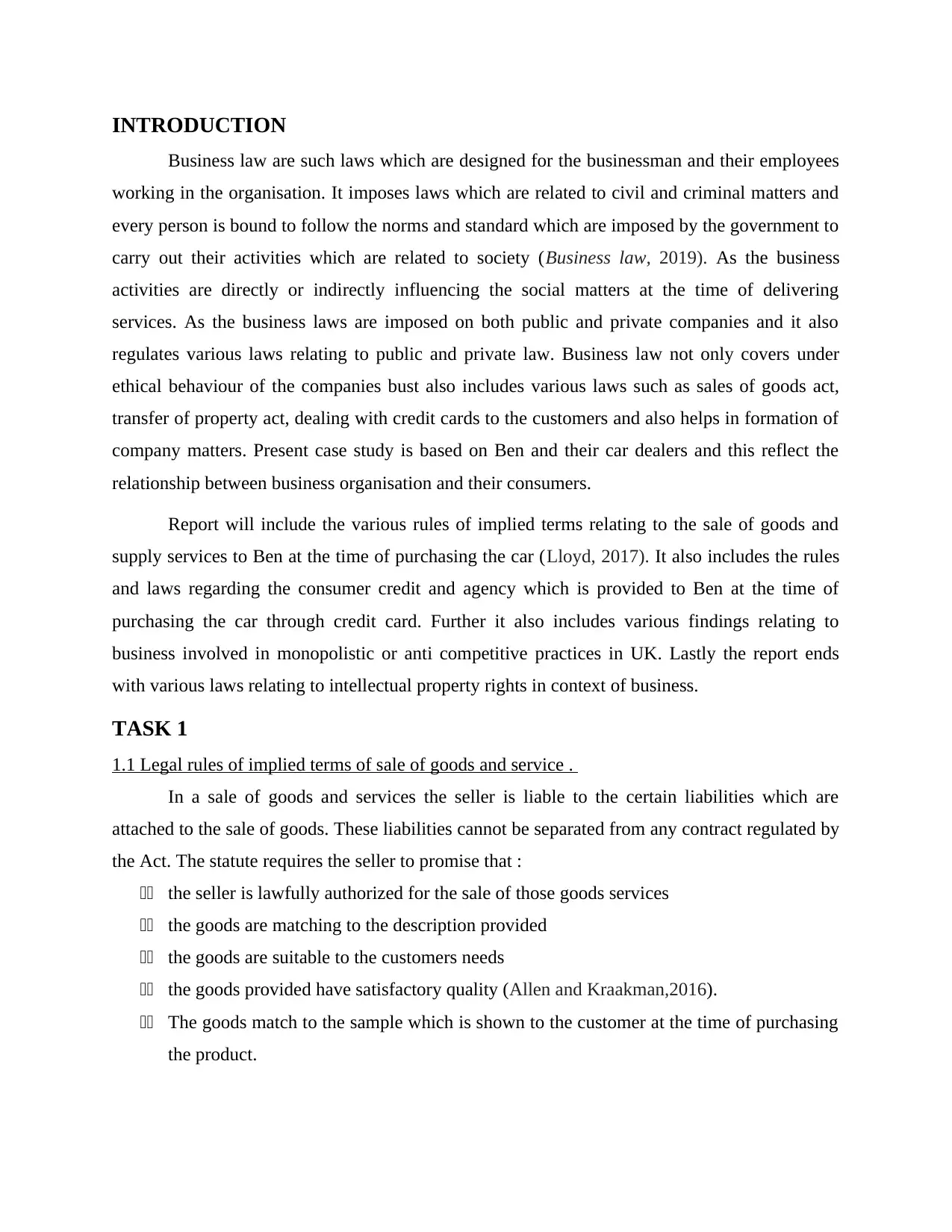
INTRODUCTION
Business law are such laws which are designed for the businessman and their employees
working in the organisation. It imposes laws which are related to civil and criminal matters and
every person is bound to follow the norms and standard which are imposed by the government to
carry out their activities which are related to society (Business law, 2019). As the business
activities are directly or indirectly influencing the social matters at the time of delivering
services. As the business laws are imposed on both public and private companies and it also
regulates various laws relating to public and private law. Business law not only covers under
ethical behaviour of the companies bust also includes various laws such as sales of goods act,
transfer of property act, dealing with credit cards to the customers and also helps in formation of
company matters. Present case study is based on Ben and their car dealers and this reflect the
relationship between business organisation and their consumers.
Report will include the various rules of implied terms relating to the sale of goods and
supply services to Ben at the time of purchasing the car (Lloyd, 2017). It also includes the rules
and laws regarding the consumer credit and agency which is provided to Ben at the time of
purchasing the car through credit card. Further it also includes various findings relating to
business involved in monopolistic or anti competitive practices in UK. Lastly the report ends
with various laws relating to intellectual property rights in context of business.
TASK 1
1.1 Legal rules of implied terms of sale of goods and service .
In a sale of goods and services the seller is liable to the certain liabilities which are
attached to the sale of goods. These liabilities cannot be separated from any contract regulated by
the Act. The statute requires the seller to promise that :
11 the seller is lawfully authorized for the sale of those goods services
11 the goods are matching to the description provided
11 the goods are suitable to the customers needs
11 the goods provided have satisfactory quality (Allen and Kraakman,2016).
11 The goods match to the sample which is shown to the customer at the time of purchasing
the product.
Business law are such laws which are designed for the businessman and their employees
working in the organisation. It imposes laws which are related to civil and criminal matters and
every person is bound to follow the norms and standard which are imposed by the government to
carry out their activities which are related to society (Business law, 2019). As the business
activities are directly or indirectly influencing the social matters at the time of delivering
services. As the business laws are imposed on both public and private companies and it also
regulates various laws relating to public and private law. Business law not only covers under
ethical behaviour of the companies bust also includes various laws such as sales of goods act,
transfer of property act, dealing with credit cards to the customers and also helps in formation of
company matters. Present case study is based on Ben and their car dealers and this reflect the
relationship between business organisation and their consumers.
Report will include the various rules of implied terms relating to the sale of goods and
supply services to Ben at the time of purchasing the car (Lloyd, 2017). It also includes the rules
and laws regarding the consumer credit and agency which is provided to Ben at the time of
purchasing the car through credit card. Further it also includes various findings relating to
business involved in monopolistic or anti competitive practices in UK. Lastly the report ends
with various laws relating to intellectual property rights in context of business.
TASK 1
1.1 Legal rules of implied terms of sale of goods and service .
In a sale of goods and services the seller is liable to the certain liabilities which are
attached to the sale of goods. These liabilities cannot be separated from any contract regulated by
the Act. The statute requires the seller to promise that :
11 the seller is lawfully authorized for the sale of those goods services
11 the goods are matching to the description provided
11 the goods are suitable to the customers needs
11 the goods provided have satisfactory quality (Allen and Kraakman,2016).
11 The goods match to the sample which is shown to the customer at the time of purchasing
the product.
⊘ This is a preview!⊘
Do you want full access?
Subscribe today to unlock all pages.

Trusted by 1+ million students worldwide
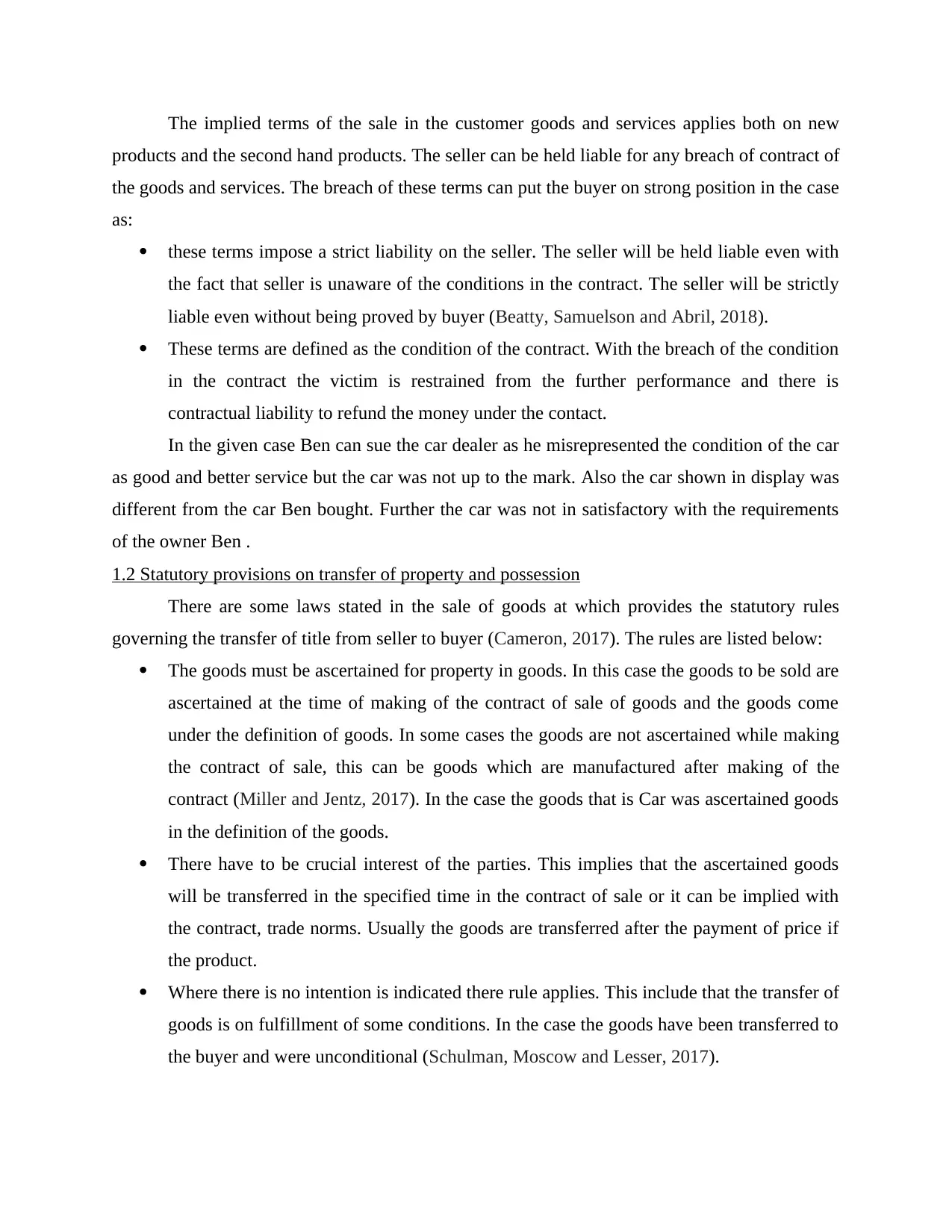
The implied terms of the sale in the customer goods and services applies both on new
products and the second hand products. The seller can be held liable for any breach of contract of
the goods and services. The breach of these terms can put the buyer on strong position in the case
as:
these terms impose a strict liability on the seller. The seller will be held liable even with
the fact that seller is unaware of the conditions in the contract. The seller will be strictly
liable even without being proved by buyer (Beatty, Samuelson and Abril, 2018).
These terms are defined as the condition of the contract. With the breach of the condition
in the contract the victim is restrained from the further performance and there is
contractual liability to refund the money under the contact.
In the given case Ben can sue the car dealer as he misrepresented the condition of the car
as good and better service but the car was not up to the mark. Also the car shown in display was
different from the car Ben bought. Further the car was not in satisfactory with the requirements
of the owner Ben .
1.2 Statutory provisions on transfer of property and possession
There are some laws stated in the sale of goods at which provides the statutory rules
governing the transfer of title from seller to buyer (Cameron, 2017). The rules are listed below:
The goods must be ascertained for property in goods. In this case the goods to be sold are
ascertained at the time of making of the contract of sale of goods and the goods come
under the definition of goods. In some cases the goods are not ascertained while making
the contract of sale, this can be goods which are manufactured after making of the
contract (Miller and Jentz, 2017). In the case the goods that is Car was ascertained goods
in the definition of the goods.
There have to be crucial interest of the parties. This implies that the ascertained goods
will be transferred in the specified time in the contract of sale or it can be implied with
the contract, trade norms. Usually the goods are transferred after the payment of price if
the product.
Where there is no intention is indicated there rule applies. This include that the transfer of
goods is on fulfillment of some conditions. In the case the goods have been transferred to
the buyer and were unconditional (Schulman, Moscow and Lesser, 2017).
products and the second hand products. The seller can be held liable for any breach of contract of
the goods and services. The breach of these terms can put the buyer on strong position in the case
as:
these terms impose a strict liability on the seller. The seller will be held liable even with
the fact that seller is unaware of the conditions in the contract. The seller will be strictly
liable even without being proved by buyer (Beatty, Samuelson and Abril, 2018).
These terms are defined as the condition of the contract. With the breach of the condition
in the contract the victim is restrained from the further performance and there is
contractual liability to refund the money under the contact.
In the given case Ben can sue the car dealer as he misrepresented the condition of the car
as good and better service but the car was not up to the mark. Also the car shown in display was
different from the car Ben bought. Further the car was not in satisfactory with the requirements
of the owner Ben .
1.2 Statutory provisions on transfer of property and possession
There are some laws stated in the sale of goods at which provides the statutory rules
governing the transfer of title from seller to buyer (Cameron, 2017). The rules are listed below:
The goods must be ascertained for property in goods. In this case the goods to be sold are
ascertained at the time of making of the contract of sale of goods and the goods come
under the definition of goods. In some cases the goods are not ascertained while making
the contract of sale, this can be goods which are manufactured after making of the
contract (Miller and Jentz, 2017). In the case the goods that is Car was ascertained goods
in the definition of the goods.
There have to be crucial interest of the parties. This implies that the ascertained goods
will be transferred in the specified time in the contract of sale or it can be implied with
the contract, trade norms. Usually the goods are transferred after the payment of price if
the product.
Where there is no intention is indicated there rule applies. This include that the transfer of
goods is on fulfillment of some conditions. In the case the goods have been transferred to
the buyer and were unconditional (Schulman, Moscow and Lesser, 2017).
Paraphrase This Document
Need a fresh take? Get an instant paraphrase of this document with our AI Paraphraser
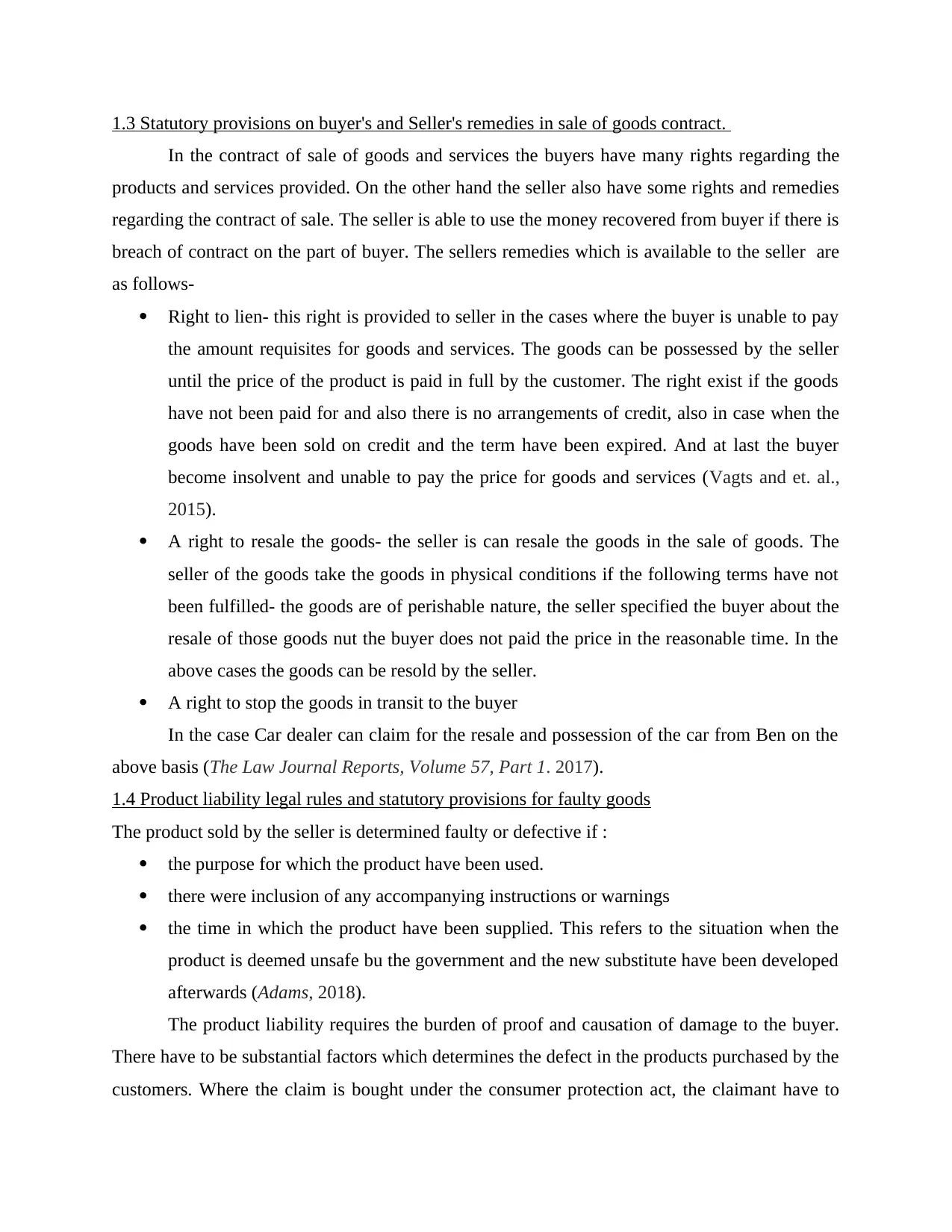
1.3 Statutory provisions on buyer's and Seller's remedies in sale of goods contract.
In the contract of sale of goods and services the buyers have many rights regarding the
products and services provided. On the other hand the seller also have some rights and remedies
regarding the contract of sale. The seller is able to use the money recovered from buyer if there is
breach of contract on the part of buyer. The sellers remedies which is available to the seller are
as follows-
Right to lien- this right is provided to seller in the cases where the buyer is unable to pay
the amount requisites for goods and services. The goods can be possessed by the seller
until the price of the product is paid in full by the customer. The right exist if the goods
have not been paid for and also there is no arrangements of credit, also in case when the
goods have been sold on credit and the term have been expired. And at last the buyer
become insolvent and unable to pay the price for goods and services (Vagts and et. al.,
2015).
A right to resale the goods- the seller is can resale the goods in the sale of goods. The
seller of the goods take the goods in physical conditions if the following terms have not
been fulfilled- the goods are of perishable nature, the seller specified the buyer about the
resale of those goods nut the buyer does not paid the price in the reasonable time. In the
above cases the goods can be resold by the seller.
A right to stop the goods in transit to the buyer
In the case Car dealer can claim for the resale and possession of the car from Ben on the
above basis (The Law Journal Reports, Volume 57, Part 1. 2017).
1.4 Product liability legal rules and statutory provisions for faulty goods
The product sold by the seller is determined faulty or defective if :
the purpose for which the product have been used.
there were inclusion of any accompanying instructions or warnings
the time in which the product have been supplied. This refers to the situation when the
product is deemed unsafe bu the government and the new substitute have been developed
afterwards (Adams, 2018).
The product liability requires the burden of proof and causation of damage to the buyer.
There have to be substantial factors which determines the defect in the products purchased by the
customers. Where the claim is bought under the consumer protection act, the claimant have to
In the contract of sale of goods and services the buyers have many rights regarding the
products and services provided. On the other hand the seller also have some rights and remedies
regarding the contract of sale. The seller is able to use the money recovered from buyer if there is
breach of contract on the part of buyer. The sellers remedies which is available to the seller are
as follows-
Right to lien- this right is provided to seller in the cases where the buyer is unable to pay
the amount requisites for goods and services. The goods can be possessed by the seller
until the price of the product is paid in full by the customer. The right exist if the goods
have not been paid for and also there is no arrangements of credit, also in case when the
goods have been sold on credit and the term have been expired. And at last the buyer
become insolvent and unable to pay the price for goods and services (Vagts and et. al.,
2015).
A right to resale the goods- the seller is can resale the goods in the sale of goods. The
seller of the goods take the goods in physical conditions if the following terms have not
been fulfilled- the goods are of perishable nature, the seller specified the buyer about the
resale of those goods nut the buyer does not paid the price in the reasonable time. In the
above cases the goods can be resold by the seller.
A right to stop the goods in transit to the buyer
In the case Car dealer can claim for the resale and possession of the car from Ben on the
above basis (The Law Journal Reports, Volume 57, Part 1. 2017).
1.4 Product liability legal rules and statutory provisions for faulty goods
The product sold by the seller is determined faulty or defective if :
the purpose for which the product have been used.
there were inclusion of any accompanying instructions or warnings
the time in which the product have been supplied. This refers to the situation when the
product is deemed unsafe bu the government and the new substitute have been developed
afterwards (Adams, 2018).
The product liability requires the burden of proof and causation of damage to the buyer.
There have to be substantial factors which determines the defect in the products purchased by the
customers. Where the claim is bought under the consumer protection act, the claimant have to
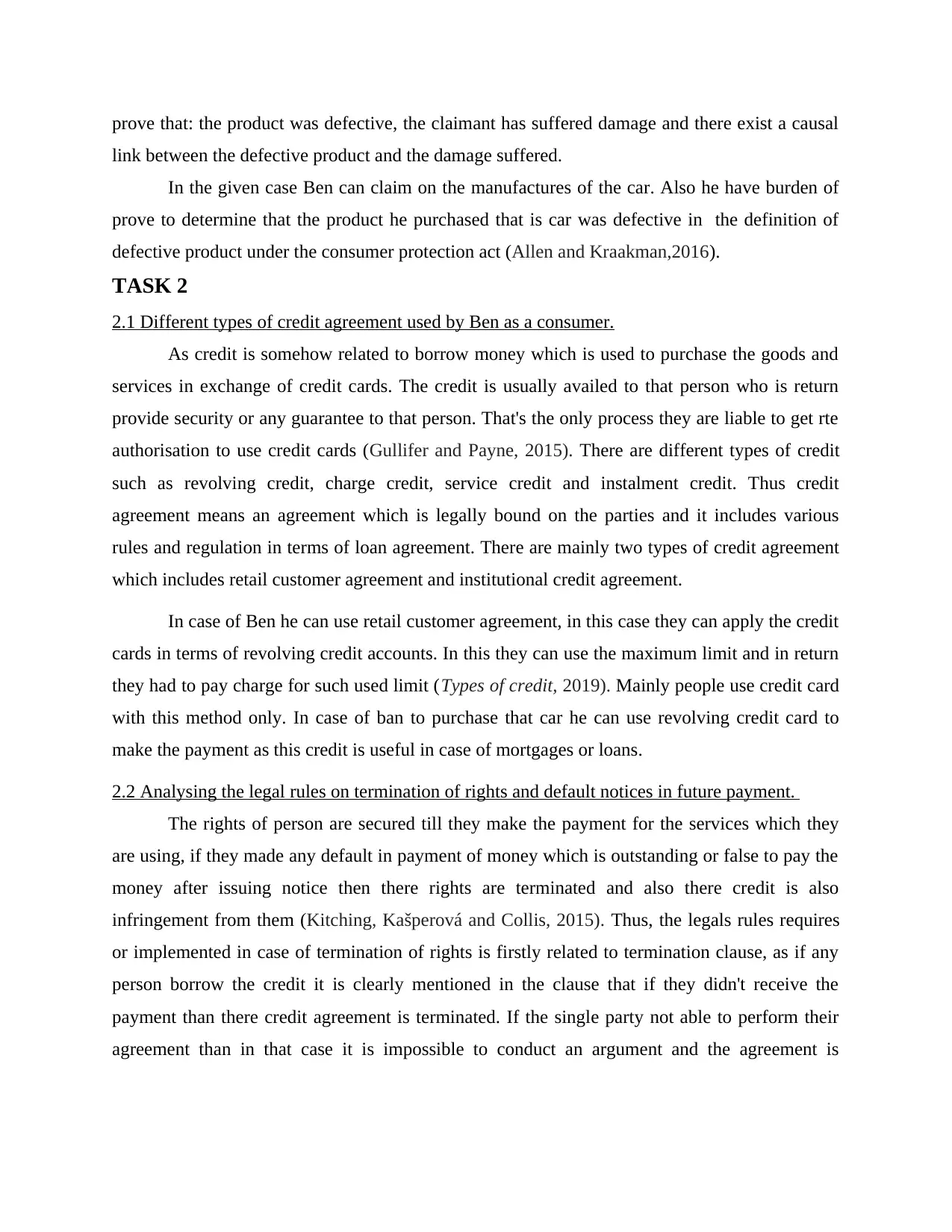
prove that: the product was defective, the claimant has suffered damage and there exist a causal
link between the defective product and the damage suffered.
In the given case Ben can claim on the manufactures of the car. Also he have burden of
prove to determine that the product he purchased that is car was defective in the definition of
defective product under the consumer protection act (Allen and Kraakman,2016).
TASK 2
2.1 Different types of credit agreement used by Ben as a consumer.
As credit is somehow related to borrow money which is used to purchase the goods and
services in exchange of credit cards. The credit is usually availed to that person who is return
provide security or any guarantee to that person. That's the only process they are liable to get rte
authorisation to use credit cards (Gullifer and Payne, 2015). There are different types of credit
such as revolving credit, charge credit, service credit and instalment credit. Thus credit
agreement means an agreement which is legally bound on the parties and it includes various
rules and regulation in terms of loan agreement. There are mainly two types of credit agreement
which includes retail customer agreement and institutional credit agreement.
In case of Ben he can use retail customer agreement, in this case they can apply the credit
cards in terms of revolving credit accounts. In this they can use the maximum limit and in return
they had to pay charge for such used limit (Types of credit, 2019). Mainly people use credit card
with this method only. In case of ban to purchase that car he can use revolving credit card to
make the payment as this credit is useful in case of mortgages or loans.
2.2 Analysing the legal rules on termination of rights and default notices in future payment.
The rights of person are secured till they make the payment for the services which they
are using, if they made any default in payment of money which is outstanding or false to pay the
money after issuing notice then there rights are terminated and also there credit is also
infringement from them (Kitching, Kašperová and Collis, 2015). Thus, the legals rules requires
or implemented in case of termination of rights is firstly related to termination clause, as if any
person borrow the credit it is clearly mentioned in the clause that if they didn't receive the
payment than there credit agreement is terminated. If the single party not able to perform their
agreement than in that case it is impossible to conduct an argument and the agreement is
link between the defective product and the damage suffered.
In the given case Ben can claim on the manufactures of the car. Also he have burden of
prove to determine that the product he purchased that is car was defective in the definition of
defective product under the consumer protection act (Allen and Kraakman,2016).
TASK 2
2.1 Different types of credit agreement used by Ben as a consumer.
As credit is somehow related to borrow money which is used to purchase the goods and
services in exchange of credit cards. The credit is usually availed to that person who is return
provide security or any guarantee to that person. That's the only process they are liable to get rte
authorisation to use credit cards (Gullifer and Payne, 2015). There are different types of credit
such as revolving credit, charge credit, service credit and instalment credit. Thus credit
agreement means an agreement which is legally bound on the parties and it includes various
rules and regulation in terms of loan agreement. There are mainly two types of credit agreement
which includes retail customer agreement and institutional credit agreement.
In case of Ben he can use retail customer agreement, in this case they can apply the credit
cards in terms of revolving credit accounts. In this they can use the maximum limit and in return
they had to pay charge for such used limit (Types of credit, 2019). Mainly people use credit card
with this method only. In case of ban to purchase that car he can use revolving credit card to
make the payment as this credit is useful in case of mortgages or loans.
2.2 Analysing the legal rules on termination of rights and default notices in future payment.
The rights of person are secured till they make the payment for the services which they
are using, if they made any default in payment of money which is outstanding or false to pay the
money after issuing notice then there rights are terminated and also there credit is also
infringement from them (Kitching, Kašperová and Collis, 2015). Thus, the legals rules requires
or implemented in case of termination of rights is firstly related to termination clause, as if any
person borrow the credit it is clearly mentioned in the clause that if they didn't receive the
payment than there credit agreement is terminated. If the single party not able to perform their
agreement than in that case it is impossible to conduct an argument and the agreement is
⊘ This is a preview!⊘
Do you want full access?
Subscribe today to unlock all pages.

Trusted by 1+ million students worldwide
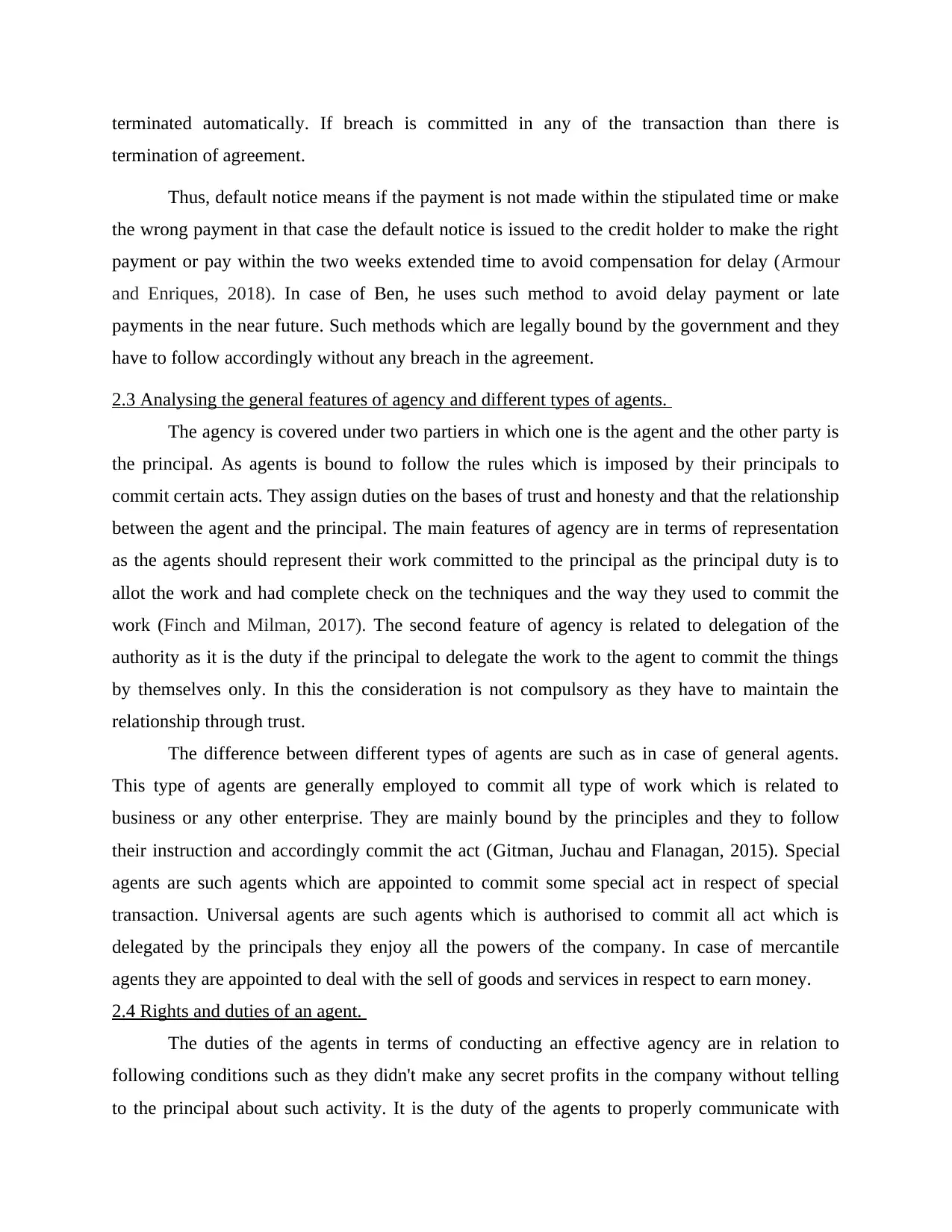
terminated automatically. If breach is committed in any of the transaction than there is
termination of agreement.
Thus, default notice means if the payment is not made within the stipulated time or make
the wrong payment in that case the default notice is issued to the credit holder to make the right
payment or pay within the two weeks extended time to avoid compensation for delay (Armour
and Enriques, 2018). In case of Ben, he uses such method to avoid delay payment or late
payments in the near future. Such methods which are legally bound by the government and they
have to follow accordingly without any breach in the agreement.
2.3 Analysing the general features of agency and different types of agents.
The agency is covered under two partiers in which one is the agent and the other party is
the principal. As agents is bound to follow the rules which is imposed by their principals to
commit certain acts. They assign duties on the bases of trust and honesty and that the relationship
between the agent and the principal. The main features of agency are in terms of representation
as the agents should represent their work committed to the principal as the principal duty is to
allot the work and had complete check on the techniques and the way they used to commit the
work (Finch and Milman, 2017). The second feature of agency is related to delegation of the
authority as it is the duty if the principal to delegate the work to the agent to commit the things
by themselves only. In this the consideration is not compulsory as they have to maintain the
relationship through trust.
The difference between different types of agents are such as in case of general agents.
This type of agents are generally employed to commit all type of work which is related to
business or any other enterprise. They are mainly bound by the principles and they to follow
their instruction and accordingly commit the act (Gitman, Juchau and Flanagan, 2015). Special
agents are such agents which are appointed to commit some special act in respect of special
transaction. Universal agents are such agents which is authorised to commit all act which is
delegated by the principals they enjoy all the powers of the company. In case of mercantile
agents they are appointed to deal with the sell of goods and services in respect to earn money.
2.4 Rights and duties of an agent.
The duties of the agents in terms of conducting an effective agency are in relation to
following conditions such as they didn't make any secret profits in the company without telling
to the principal about such activity. It is the duty of the agents to properly communicate with
termination of agreement.
Thus, default notice means if the payment is not made within the stipulated time or make
the wrong payment in that case the default notice is issued to the credit holder to make the right
payment or pay within the two weeks extended time to avoid compensation for delay (Armour
and Enriques, 2018). In case of Ben, he uses such method to avoid delay payment or late
payments in the near future. Such methods which are legally bound by the government and they
have to follow accordingly without any breach in the agreement.
2.3 Analysing the general features of agency and different types of agents.
The agency is covered under two partiers in which one is the agent and the other party is
the principal. As agents is bound to follow the rules which is imposed by their principals to
commit certain acts. They assign duties on the bases of trust and honesty and that the relationship
between the agent and the principal. The main features of agency are in terms of representation
as the agents should represent their work committed to the principal as the principal duty is to
allot the work and had complete check on the techniques and the way they used to commit the
work (Finch and Milman, 2017). The second feature of agency is related to delegation of the
authority as it is the duty if the principal to delegate the work to the agent to commit the things
by themselves only. In this the consideration is not compulsory as they have to maintain the
relationship through trust.
The difference between different types of agents are such as in case of general agents.
This type of agents are generally employed to commit all type of work which is related to
business or any other enterprise. They are mainly bound by the principles and they to follow
their instruction and accordingly commit the act (Gitman, Juchau and Flanagan, 2015). Special
agents are such agents which are appointed to commit some special act in respect of special
transaction. Universal agents are such agents which is authorised to commit all act which is
delegated by the principals they enjoy all the powers of the company. In case of mercantile
agents they are appointed to deal with the sell of goods and services in respect to earn money.
2.4 Rights and duties of an agent.
The duties of the agents in terms of conducting an effective agency are in relation to
following conditions such as they didn't make any secret profits in the company without telling
to the principal about such activity. It is the duty of the agents to properly communicate with
Paraphrase This Document
Need a fresh take? Get an instant paraphrase of this document with our AI Paraphraser
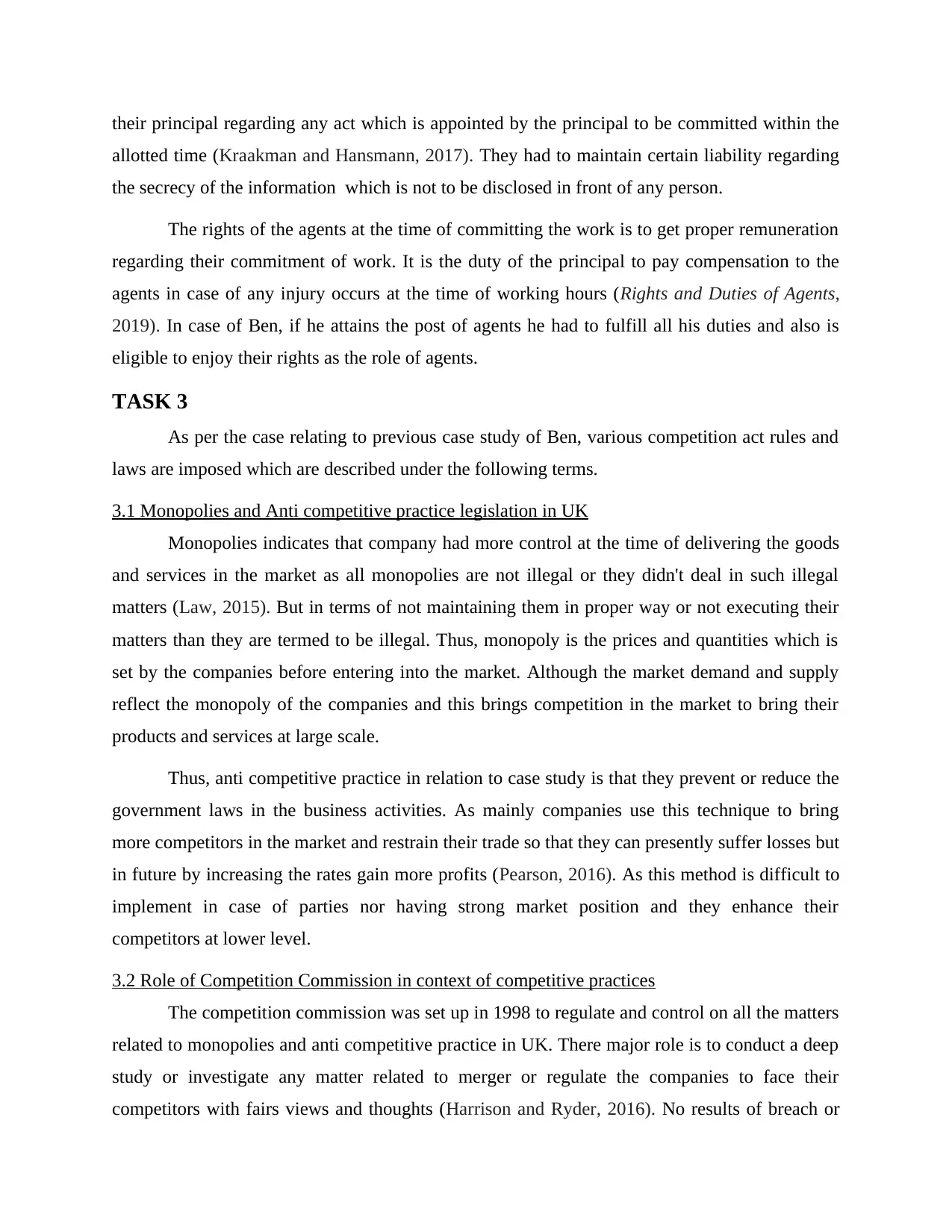
their principal regarding any act which is appointed by the principal to be committed within the
allotted time (Kraakman and Hansmann, 2017). They had to maintain certain liability regarding
the secrecy of the information which is not to be disclosed in front of any person.
The rights of the agents at the time of committing the work is to get proper remuneration
regarding their commitment of work. It is the duty of the principal to pay compensation to the
agents in case of any injury occurs at the time of working hours (Rights and Duties of Agents,
2019). In case of Ben, if he attains the post of agents he had to fulfill all his duties and also is
eligible to enjoy their rights as the role of agents.
TASK 3
As per the case relating to previous case study of Ben, various competition act rules and
laws are imposed which are described under the following terms.
3.1 Monopolies and Anti competitive practice legislation in UK
Monopolies indicates that company had more control at the time of delivering the goods
and services in the market as all monopolies are not illegal or they didn't deal in such illegal
matters (Law, 2015). But in terms of not maintaining them in proper way or not executing their
matters than they are termed to be illegal. Thus, monopoly is the prices and quantities which is
set by the companies before entering into the market. Although the market demand and supply
reflect the monopoly of the companies and this brings competition in the market to bring their
products and services at large scale.
Thus, anti competitive practice in relation to case study is that they prevent or reduce the
government laws in the business activities. As mainly companies use this technique to bring
more competitors in the market and restrain their trade so that they can presently suffer losses but
in future by increasing the rates gain more profits (Pearson, 2016). As this method is difficult to
implement in case of parties nor having strong market position and they enhance their
competitors at lower level.
3.2 Role of Competition Commission in context of competitive practices
The competition commission was set up in 1998 to regulate and control on all the matters
related to monopolies and anti competitive practice in UK. There major role is to conduct a deep
study or investigate any matter related to merger or regulate the companies to face their
competitors with fairs views and thoughts (Harrison and Ryder, 2016). No results of breach or
allotted time (Kraakman and Hansmann, 2017). They had to maintain certain liability regarding
the secrecy of the information which is not to be disclosed in front of any person.
The rights of the agents at the time of committing the work is to get proper remuneration
regarding their commitment of work. It is the duty of the principal to pay compensation to the
agents in case of any injury occurs at the time of working hours (Rights and Duties of Agents,
2019). In case of Ben, if he attains the post of agents he had to fulfill all his duties and also is
eligible to enjoy their rights as the role of agents.
TASK 3
As per the case relating to previous case study of Ben, various competition act rules and
laws are imposed which are described under the following terms.
3.1 Monopolies and Anti competitive practice legislation in UK
Monopolies indicates that company had more control at the time of delivering the goods
and services in the market as all monopolies are not illegal or they didn't deal in such illegal
matters (Law, 2015). But in terms of not maintaining them in proper way or not executing their
matters than they are termed to be illegal. Thus, monopoly is the prices and quantities which is
set by the companies before entering into the market. Although the market demand and supply
reflect the monopoly of the companies and this brings competition in the market to bring their
products and services at large scale.
Thus, anti competitive practice in relation to case study is that they prevent or reduce the
government laws in the business activities. As mainly companies use this technique to bring
more competitors in the market and restrain their trade so that they can presently suffer losses but
in future by increasing the rates gain more profits (Pearson, 2016). As this method is difficult to
implement in case of parties nor having strong market position and they enhance their
competitors at lower level.
3.2 Role of Competition Commission in context of competitive practices
The competition commission was set up in 1998 to regulate and control on all the matters
related to monopolies and anti competitive practice in UK. There major role is to conduct a deep
study or investigate any matter related to merger or regulate the companies to face their
competitors with fairs views and thoughts (Harrison and Ryder, 2016). No results of breach or
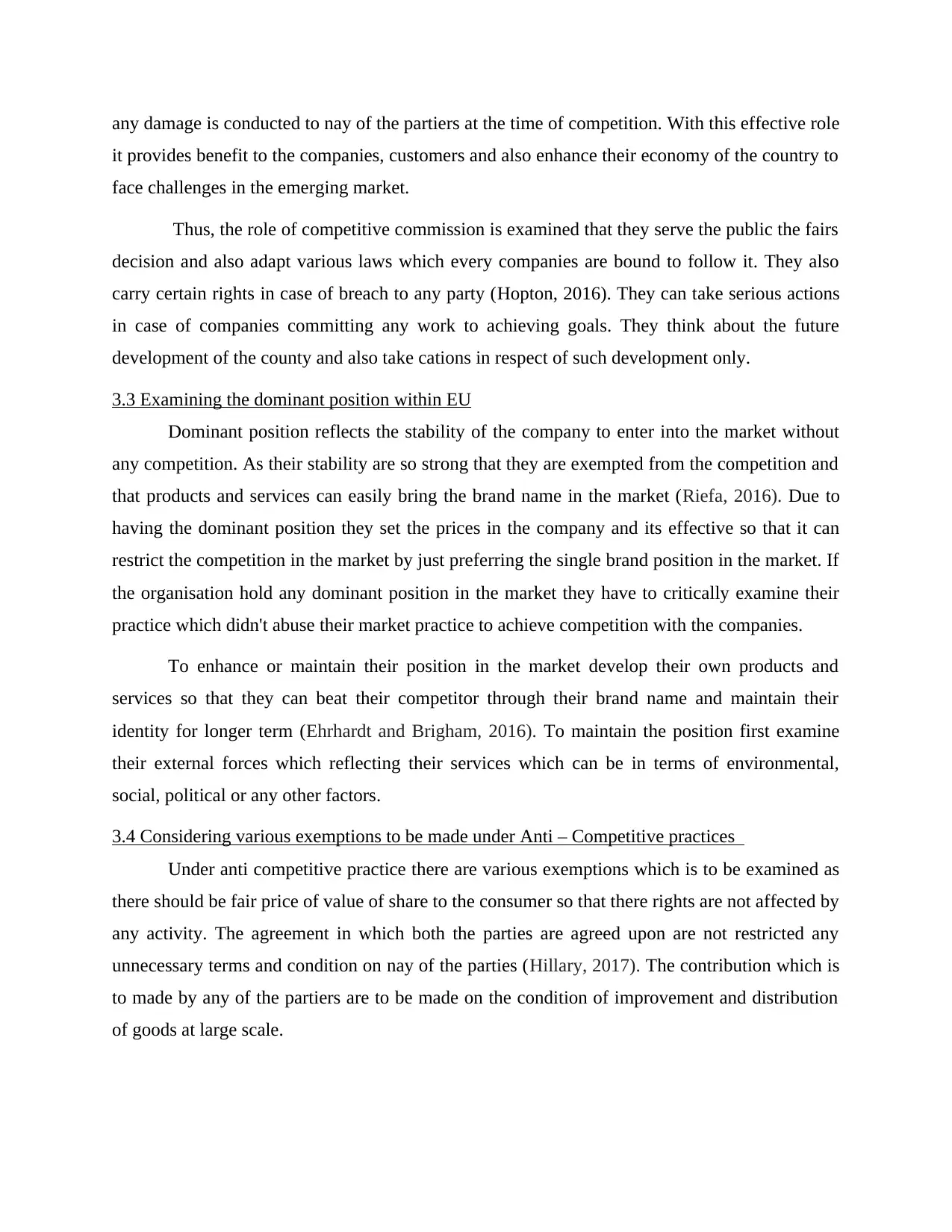
any damage is conducted to nay of the partiers at the time of competition. With this effective role
it provides benefit to the companies, customers and also enhance their economy of the country to
face challenges in the emerging market.
Thus, the role of competitive commission is examined that they serve the public the fairs
decision and also adapt various laws which every companies are bound to follow it. They also
carry certain rights in case of breach to any party (Hopton, 2016). They can take serious actions
in case of companies committing any work to achieving goals. They think about the future
development of the county and also take cations in respect of such development only.
3.3 Examining the dominant position within EU
Dominant position reflects the stability of the company to enter into the market without
any competition. As their stability are so strong that they are exempted from the competition and
that products and services can easily bring the brand name in the market (Riefa, 2016). Due to
having the dominant position they set the prices in the company and its effective so that it can
restrict the competition in the market by just preferring the single brand position in the market. If
the organisation hold any dominant position in the market they have to critically examine their
practice which didn't abuse their market practice to achieve competition with the companies.
To enhance or maintain their position in the market develop their own products and
services so that they can beat their competitor through their brand name and maintain their
identity for longer term (Ehrhardt and Brigham, 2016). To maintain the position first examine
their external forces which reflecting their services which can be in terms of environmental,
social, political or any other factors.
3.4 Considering various exemptions to be made under Anti – Competitive practices
Under anti competitive practice there are various exemptions which is to be examined as
there should be fair price of value of share to the consumer so that there rights are not affected by
any activity. The agreement in which both the parties are agreed upon are not restricted any
unnecessary terms and condition on nay of the parties (Hillary, 2017). The contribution which is
to made by any of the partiers are to be made on the condition of improvement and distribution
of goods at large scale.
it provides benefit to the companies, customers and also enhance their economy of the country to
face challenges in the emerging market.
Thus, the role of competitive commission is examined that they serve the public the fairs
decision and also adapt various laws which every companies are bound to follow it. They also
carry certain rights in case of breach to any party (Hopton, 2016). They can take serious actions
in case of companies committing any work to achieving goals. They think about the future
development of the county and also take cations in respect of such development only.
3.3 Examining the dominant position within EU
Dominant position reflects the stability of the company to enter into the market without
any competition. As their stability are so strong that they are exempted from the competition and
that products and services can easily bring the brand name in the market (Riefa, 2016). Due to
having the dominant position they set the prices in the company and its effective so that it can
restrict the competition in the market by just preferring the single brand position in the market. If
the organisation hold any dominant position in the market they have to critically examine their
practice which didn't abuse their market practice to achieve competition with the companies.
To enhance or maintain their position in the market develop their own products and
services so that they can beat their competitor through their brand name and maintain their
identity for longer term (Ehrhardt and Brigham, 2016). To maintain the position first examine
their external forces which reflecting their services which can be in terms of environmental,
social, political or any other factors.
3.4 Considering various exemptions to be made under Anti – Competitive practices
Under anti competitive practice there are various exemptions which is to be examined as
there should be fair price of value of share to the consumer so that there rights are not affected by
any activity. The agreement in which both the parties are agreed upon are not restricted any
unnecessary terms and condition on nay of the parties (Hillary, 2017). The contribution which is
to made by any of the partiers are to be made on the condition of improvement and distribution
of goods at large scale.
⊘ This is a preview!⊘
Do you want full access?
Subscribe today to unlock all pages.

Trusted by 1+ million students worldwide
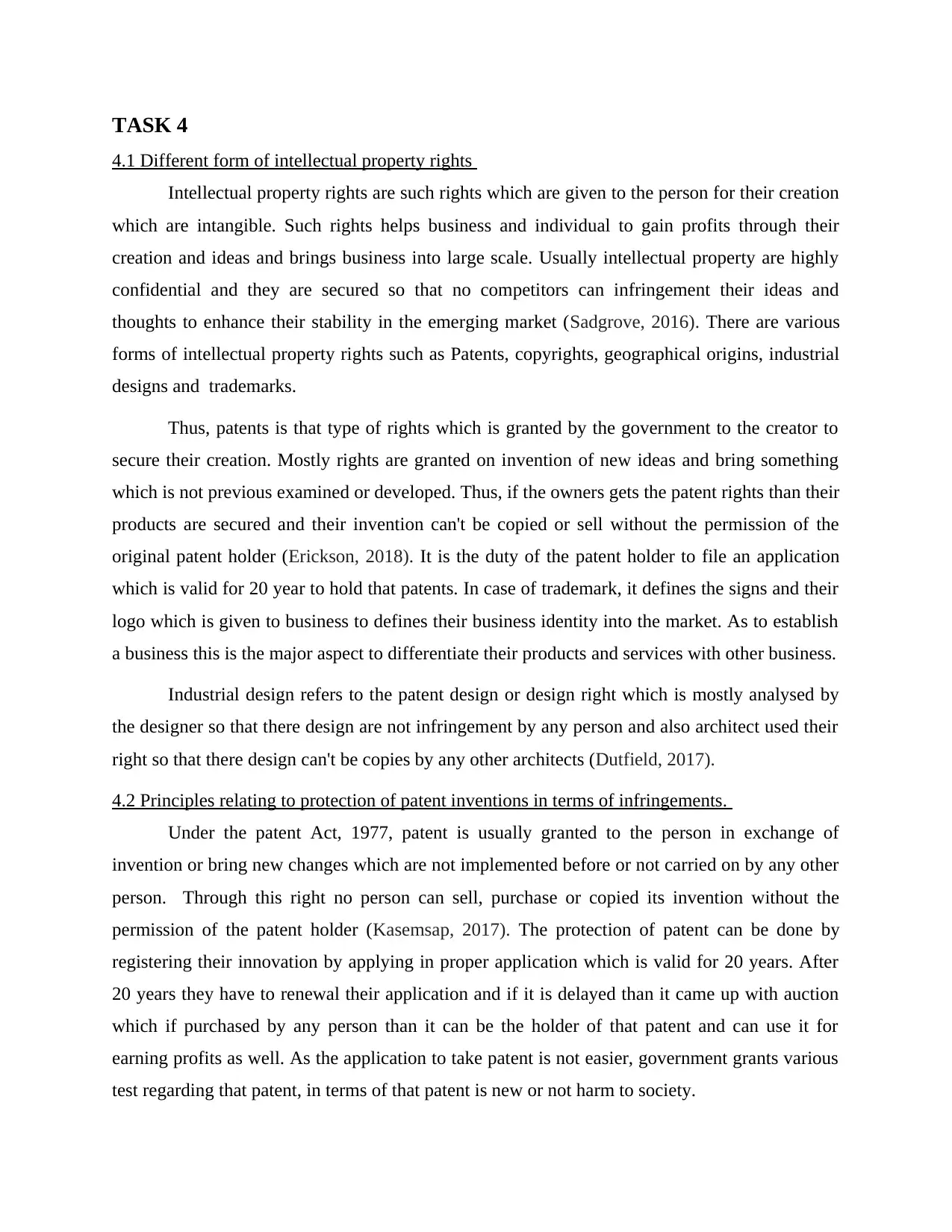
TASK 4
4.1 Different form of intellectual property rights
Intellectual property rights are such rights which are given to the person for their creation
which are intangible. Such rights helps business and individual to gain profits through their
creation and ideas and brings business into large scale. Usually intellectual property are highly
confidential and they are secured so that no competitors can infringement their ideas and
thoughts to enhance their stability in the emerging market (Sadgrove, 2016). There are various
forms of intellectual property rights such as Patents, copyrights, geographical origins, industrial
designs and trademarks.
Thus, patents is that type of rights which is granted by the government to the creator to
secure their creation. Mostly rights are granted on invention of new ideas and bring something
which is not previous examined or developed. Thus, if the owners gets the patent rights than their
products are secured and their invention can't be copied or sell without the permission of the
original patent holder (Erickson, 2018). It is the duty of the patent holder to file an application
which is valid for 20 year to hold that patents. In case of trademark, it defines the signs and their
logo which is given to business to defines their business identity into the market. As to establish
a business this is the major aspect to differentiate their products and services with other business.
Industrial design refers to the patent design or design right which is mostly analysed by
the designer so that there design are not infringement by any person and also architect used their
right so that there design can't be copies by any other architects (Dutfield, 2017).
4.2 Principles relating to protection of patent inventions in terms of infringements.
Under the patent Act, 1977, patent is usually granted to the person in exchange of
invention or bring new changes which are not implemented before or not carried on by any other
person. Through this right no person can sell, purchase or copied its invention without the
permission of the patent holder (Kasemsap, 2017). The protection of patent can be done by
registering their innovation by applying in proper application which is valid for 20 years. After
20 years they have to renewal their application and if it is delayed than it came up with auction
which if purchased by any person than it can be the holder of that patent and can use it for
earning profits as well. As the application to take patent is not easier, government grants various
test regarding that patent, in terms of that patent is new or not harm to society.
4.1 Different form of intellectual property rights
Intellectual property rights are such rights which are given to the person for their creation
which are intangible. Such rights helps business and individual to gain profits through their
creation and ideas and brings business into large scale. Usually intellectual property are highly
confidential and they are secured so that no competitors can infringement their ideas and
thoughts to enhance their stability in the emerging market (Sadgrove, 2016). There are various
forms of intellectual property rights such as Patents, copyrights, geographical origins, industrial
designs and trademarks.
Thus, patents is that type of rights which is granted by the government to the creator to
secure their creation. Mostly rights are granted on invention of new ideas and bring something
which is not previous examined or developed. Thus, if the owners gets the patent rights than their
products are secured and their invention can't be copied or sell without the permission of the
original patent holder (Erickson, 2018). It is the duty of the patent holder to file an application
which is valid for 20 year to hold that patents. In case of trademark, it defines the signs and their
logo which is given to business to defines their business identity into the market. As to establish
a business this is the major aspect to differentiate their products and services with other business.
Industrial design refers to the patent design or design right which is mostly analysed by
the designer so that there design are not infringement by any person and also architect used their
right so that there design can't be copies by any other architects (Dutfield, 2017).
4.2 Principles relating to protection of patent inventions in terms of infringements.
Under the patent Act, 1977, patent is usually granted to the person in exchange of
invention or bring new changes which are not implemented before or not carried on by any other
person. Through this right no person can sell, purchase or copied its invention without the
permission of the patent holder (Kasemsap, 2017). The protection of patent can be done by
registering their innovation by applying in proper application which is valid for 20 years. After
20 years they have to renewal their application and if it is delayed than it came up with auction
which if purchased by any person than it can be the holder of that patent and can use it for
earning profits as well. As the application to take patent is not easier, government grants various
test regarding that patent, in terms of that patent is new or not harm to society.
Paraphrase This Document
Need a fresh take? Get an instant paraphrase of this document with our AI Paraphraser
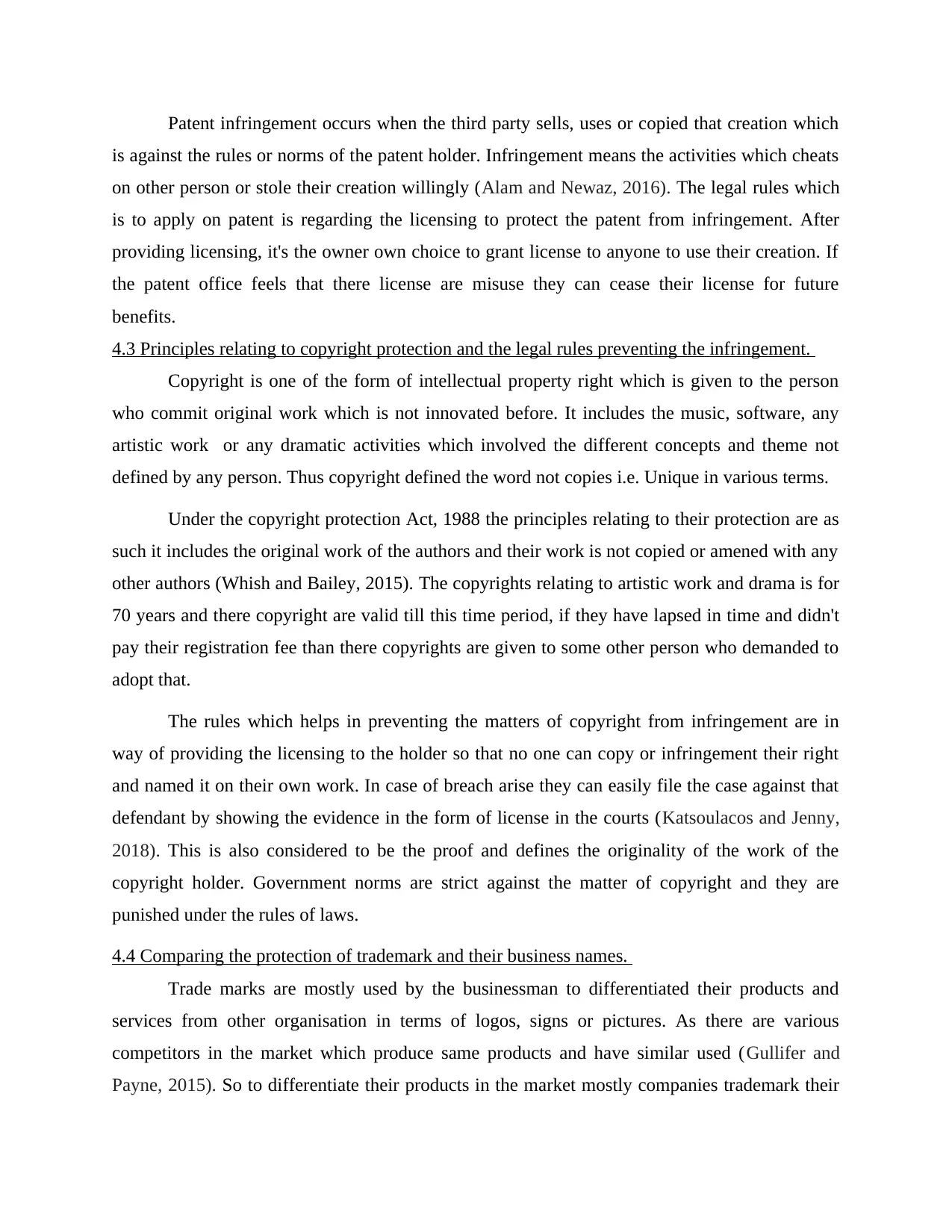
Patent infringement occurs when the third party sells, uses or copied that creation which
is against the rules or norms of the patent holder. Infringement means the activities which cheats
on other person or stole their creation willingly (Alam and Newaz, 2016). The legal rules which
is to apply on patent is regarding the licensing to protect the patent from infringement. After
providing licensing, it's the owner own choice to grant license to anyone to use their creation. If
the patent office feels that there license are misuse they can cease their license for future
benefits.
4.3 Principles relating to copyright protection and the legal rules preventing the infringement.
Copyright is one of the form of intellectual property right which is given to the person
who commit original work which is not innovated before. It includes the music, software, any
artistic work or any dramatic activities which involved the different concepts and theme not
defined by any person. Thus copyright defined the word not copies i.e. Unique in various terms.
Under the copyright protection Act, 1988 the principles relating to their protection are as
such it includes the original work of the authors and their work is not copied or amened with any
other authors (Whish and Bailey, 2015). The copyrights relating to artistic work and drama is for
70 years and there copyright are valid till this time period, if they have lapsed in time and didn't
pay their registration fee than there copyrights are given to some other person who demanded to
adopt that.
The rules which helps in preventing the matters of copyright from infringement are in
way of providing the licensing to the holder so that no one can copy or infringement their right
and named it on their own work. In case of breach arise they can easily file the case against that
defendant by showing the evidence in the form of license in the courts (Katsoulacos and Jenny,
2018). This is also considered to be the proof and defines the originality of the work of the
copyright holder. Government norms are strict against the matter of copyright and they are
punished under the rules of laws.
4.4 Comparing the protection of trademark and their business names.
Trade marks are mostly used by the businessman to differentiated their products and
services from other organisation in terms of logos, signs or pictures. As there are various
competitors in the market which produce same products and have similar used (Gullifer and
Payne, 2015). So to differentiate their products in the market mostly companies trademark their
is against the rules or norms of the patent holder. Infringement means the activities which cheats
on other person or stole their creation willingly (Alam and Newaz, 2016). The legal rules which
is to apply on patent is regarding the licensing to protect the patent from infringement. After
providing licensing, it's the owner own choice to grant license to anyone to use their creation. If
the patent office feels that there license are misuse they can cease their license for future
benefits.
4.3 Principles relating to copyright protection and the legal rules preventing the infringement.
Copyright is one of the form of intellectual property right which is given to the person
who commit original work which is not innovated before. It includes the music, software, any
artistic work or any dramatic activities which involved the different concepts and theme not
defined by any person. Thus copyright defined the word not copies i.e. Unique in various terms.
Under the copyright protection Act, 1988 the principles relating to their protection are as
such it includes the original work of the authors and their work is not copied or amened with any
other authors (Whish and Bailey, 2015). The copyrights relating to artistic work and drama is for
70 years and there copyright are valid till this time period, if they have lapsed in time and didn't
pay their registration fee than there copyrights are given to some other person who demanded to
adopt that.
The rules which helps in preventing the matters of copyright from infringement are in
way of providing the licensing to the holder so that no one can copy or infringement their right
and named it on their own work. In case of breach arise they can easily file the case against that
defendant by showing the evidence in the form of license in the courts (Katsoulacos and Jenny,
2018). This is also considered to be the proof and defines the originality of the work of the
copyright holder. Government norms are strict against the matter of copyright and they are
punished under the rules of laws.
4.4 Comparing the protection of trademark and their business names.
Trade marks are mostly used by the businessman to differentiated their products and
services from other organisation in terms of logos, signs or pictures. As there are various
competitors in the market which produce same products and have similar used (Gullifer and
Payne, 2015). So to differentiate their products in the market mostly companies trademark their
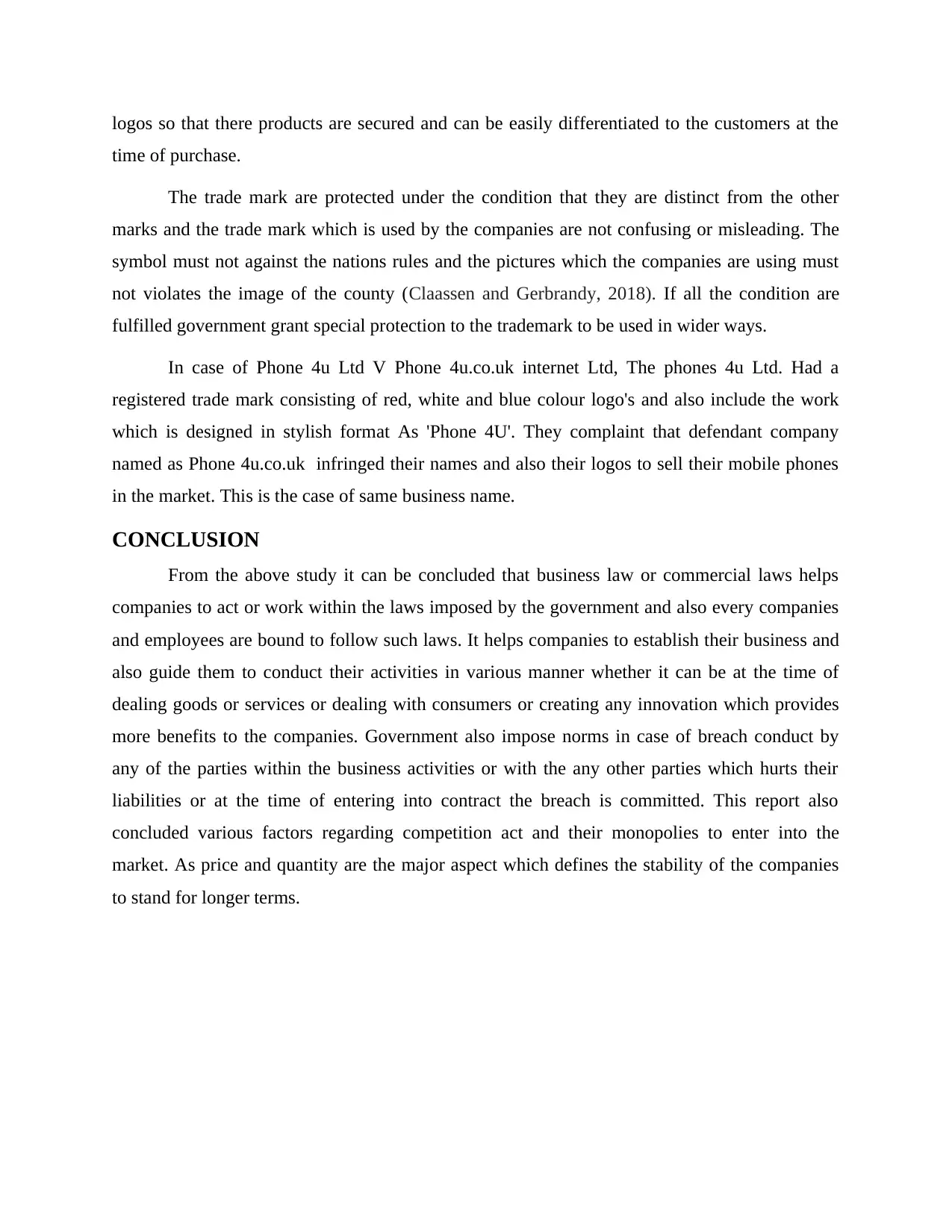
logos so that there products are secured and can be easily differentiated to the customers at the
time of purchase.
The trade mark are protected under the condition that they are distinct from the other
marks and the trade mark which is used by the companies are not confusing or misleading. The
symbol must not against the nations rules and the pictures which the companies are using must
not violates the image of the county (Claassen and Gerbrandy, 2018). If all the condition are
fulfilled government grant special protection to the trademark to be used in wider ways.
In case of Phone 4u Ltd V Phone 4u.co.uk internet Ltd, The phones 4u Ltd. Had a
registered trade mark consisting of red, white and blue colour logo's and also include the work
which is designed in stylish format As 'Phone 4U'. They complaint that defendant company
named as Phone 4u.co.uk infringed their names and also their logos to sell their mobile phones
in the market. This is the case of same business name.
CONCLUSION
From the above study it can be concluded that business law or commercial laws helps
companies to act or work within the laws imposed by the government and also every companies
and employees are bound to follow such laws. It helps companies to establish their business and
also guide them to conduct their activities in various manner whether it can be at the time of
dealing goods or services or dealing with consumers or creating any innovation which provides
more benefits to the companies. Government also impose norms in case of breach conduct by
any of the parties within the business activities or with the any other parties which hurts their
liabilities or at the time of entering into contract the breach is committed. This report also
concluded various factors regarding competition act and their monopolies to enter into the
market. As price and quantity are the major aspect which defines the stability of the companies
to stand for longer terms.
time of purchase.
The trade mark are protected under the condition that they are distinct from the other
marks and the trade mark which is used by the companies are not confusing or misleading. The
symbol must not against the nations rules and the pictures which the companies are using must
not violates the image of the county (Claassen and Gerbrandy, 2018). If all the condition are
fulfilled government grant special protection to the trademark to be used in wider ways.
In case of Phone 4u Ltd V Phone 4u.co.uk internet Ltd, The phones 4u Ltd. Had a
registered trade mark consisting of red, white and blue colour logo's and also include the work
which is designed in stylish format As 'Phone 4U'. They complaint that defendant company
named as Phone 4u.co.uk infringed their names and also their logos to sell their mobile phones
in the market. This is the case of same business name.
CONCLUSION
From the above study it can be concluded that business law or commercial laws helps
companies to act or work within the laws imposed by the government and also every companies
and employees are bound to follow such laws. It helps companies to establish their business and
also guide them to conduct their activities in various manner whether it can be at the time of
dealing goods or services or dealing with consumers or creating any innovation which provides
more benefits to the companies. Government also impose norms in case of breach conduct by
any of the parties within the business activities or with the any other parties which hurts their
liabilities or at the time of entering into contract the breach is committed. This report also
concluded various factors regarding competition act and their monopolies to enter into the
market. As price and quantity are the major aspect which defines the stability of the companies
to stand for longer terms.
⊘ This is a preview!⊘
Do you want full access?
Subscribe today to unlock all pages.

Trusted by 1+ million students worldwide
1 out of 14
Related Documents
Your All-in-One AI-Powered Toolkit for Academic Success.
+13062052269
info@desklib.com
Available 24*7 on WhatsApp / Email
![[object Object]](/_next/static/media/star-bottom.7253800d.svg)
Unlock your academic potential
Copyright © 2020–2025 A2Z Services. All Rights Reserved. Developed and managed by ZUCOL.





